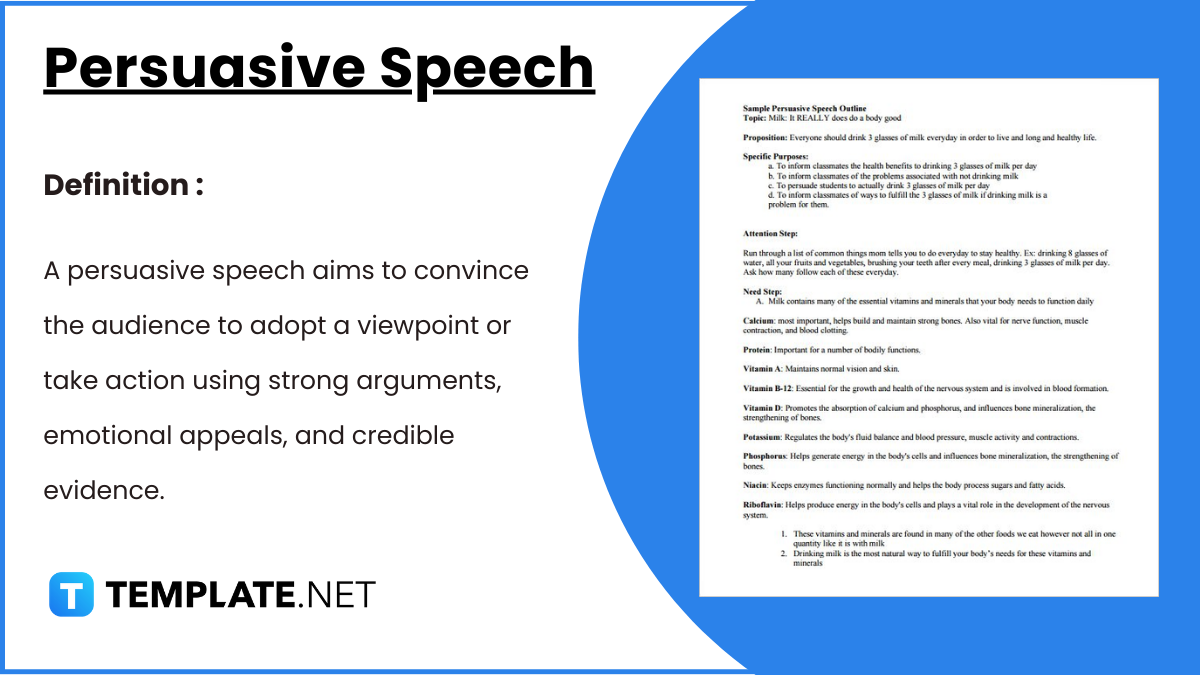
10+ Training Outline Templates – PDF, Word, Apple Pages
Before an establishment can start and continue, there must be a training outline available as to how you can go…
Nov 25, 2024
A persuasive speech is a powerful tool to influence opinions, inspire action, and communicate ideas effectively. By combining emotional appeals, logical arguments, and credible evidence, it aims to sway the audience toward a particular viewpoint. Whether you’re addressing a crowd or presenting in a small group, mastering the art of persuasion can make your message compelling and unforgettable. The success of a persuasive speech lies in its ability to connect with listeners. You can allso see on Speech in word.

Start with a strong hook to capture your audience’s attention. Use:
Explain why you are qualified to speak on this topic. Show your expertise or passion.
Clearly state your main argument or the position you are advocating for.
Briefly outline the main points you will discuss.
Divide the body into three main sections:
Summarize the problem, solution, and benefits concisely.
End with a clear and compelling call to action:
Leave the audience with something to think about:

roch.edu

Speech forms integral part of expression. This is probably one of the eventualities we cannot escape in our lifetime. How well then should we go about delivering a speech? You can do that using this sample template. You can also see more on Speech Templates. pasadena.edu

Making a speech may be an involving undertaking. Consequently, having to make one imply expending resources and time to come up with an otherwise a substantial speech. You can use this template to make the best sample outline of your speech. You can also see more on Preparation Templates. weebly.com

The speech outline basic templates are built to help you plan your next speech with ease. You do not have to create your own from scratch, because this quality template is available for free download and use.

The best thing about speech is that anyone can make it. The only thing you need to do is to create the best simple outline for the speech to make it the best. This layout template can help you do that.

Anyone can deliver a good speech. All it takes it to have the best outline and the right words will always come. Use this formal template to create the best outline for your speech. You can also see more on Essay Outline Templates.

A persuasive speech is a type of public speaking aimed at convincing the audience to adopt a particular point of view, belief, or course of action. The speaker uses logical arguments, emotional appeals, and credible evidence to influence the audience’s opinions or behavior.
Persuasive speeches are commonly used in various settings, including political campaigns, marketing presentations, educational talks, and social advocacy. They rely on effective communication skills to motivate change and build agreement among listeners.

Writing a persuasive speech involves crafting a message that convinces your audience to adopt a specific viewpoint, take an action, or agree with your perspective. Here’s a step-by-step guide:
It’s not just being on the right side of the argument that matters. You have to persuade the crowd by using rhetoric, examples, facts and figures. The need for a speech outline can hardly be understated at this point. The reasons why you need to download one of our sample speech outline easy templates are:
The three main elements are ethos (credibility), pathos (emotional appeal), and logos (logical arguments). Ethos builds trust with the audience by showing expertise or authenticity. Pathos appeals to emotions, creating a connection with the audience. Logos uses facts, data, and reasoning to strengthen arguments, ensuring logical persuasion.
You can make your speech engaging by starting with a compelling hook, such as a quote, story, or statistic. Use relatable examples to connect with your audience. Maintain a confident and enthusiastic tone throughout. Incorporate rhetorical questions to involve the audience. Finally, end with a powerful call to action.
Common mistakes include being overly aggressive, ignoring the audience’s perspective, or relying too heavily on emotions without facts. Other errors include poor organization, monotone delivery, and failing to anticipate counterarguments. Speakers may also overuse jargon, making the speech less relatable. A balanced approach with preparation ensures success.
Emotions are powerful tools in persuasive speeches, as they help create a strong connection with the audience. Emotional appeals can evoke feelings such as empathy, anger, or hope, motivating people to act. Storytelling, vivid imagery, and relatable examples are effective in eliciting emotional responses. However, excessive emotional appeals without logic can reduce credibility. A balanced use of emotion and reason ensures maximum impact.
Anticipating objections is key to addressing them effectively during your speech. Acknowledge the opposing viewpoints respectfully and provide logical, well-supported counterarguments. Use evidence such as data or expert opinions to disprove misconceptions. Remain calm and composed, avoiding defensiveness. This demonstrates confidence and helps win over skeptical audience members.

Before an establishment can start and continue, there must be a training outline available as to how you can go…

Writing an autobiography for each person is a distinctly individual experience but there are some topics that are essential to…

There are some basic criteria that one must judge a work of literature on, irrespective of genre. Typing them out…

A thesis outline templates is made to ensure that the plans for the creation of a thesis is put together…

An essential tool in planning a project, drafting a research study, writing a story, or studying for an upcoming test…

As most types of writing, the purpose of academic writing is to communicate the thoughts and ideas you have in…

Curiosity and a great sense of wonder. These are perhaps two of mankind’s most redeeming qualities, especially that these hard,…

Remember your elementary school days? As a fifth grader weren’t you already asked to write about something you love, maybe…

Business branding is a necessity. Not only does it help people to identify your business, but it also helps with…